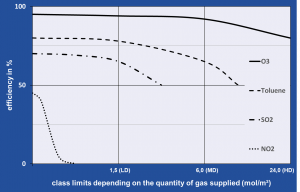Kalthoff welcomes ISO 10121-3
Introduction
The test standard ISO 10121-3 “Test methods for assessing the performance of gas-phase air cleaning media and devices for general ventilation – Part 3: Classification system for GPACDs applied to treatment of outdoor air” creates the basis for an increased use of molecular filters in Ventilation and air conditioning systems. Molecular filters, such as carbon filters, clean the air of harmful gases and molecules. In combination with fine dust filters, particles and harmful gases can be removed from the air in a holistic approach. Harmful gases can pose a threat to health just as great as particles. Kalthoff’s goal is to ensure healthy indoor air conditions through the use of filters in ventilation and air conditioning systems. Therefore, we welcome the comprehensive classification of molecular filters by ISO 10121-3.
Test procedure
According to the standard, molecular filters are classified with regard to the type of gas to be separated, the filter efficiency and the service life. Each molecular filter deals efficiently only against specific pollutant gases, so separate tests have to be carried out in the laboratory with individual gases. Nitrogen dioxide (NO2), sulphur dioxide (SO2), ozone (O3) and toluene are used for this purpose. Toluene is used as a representative for volatile organic compounds (VOCs).
The efficiency of the filter element is determined for each of the four test gases in accordance with ISO 10121-3. In the laboratory and in practice, the efficiency decreases with increasing exposure to the test gas. This is a difference to most particle filters, whose efficiency increases when particles clog the filter structure. During the test, the filter is exposed to a defined concentration until the efficiency against the respective test gas falls below 50%. This data is used to calculate an average efficiency for each of the test gases applied. The average efficiency is then rounded down in 5% increments for the individual classes.
Furthermore, a categorisation is made into classes that indicate the storage capacity or service life. During the test described above, the filter is continuously exposed to a fixed concentration of the test gas. In this way, the total quantity applied (in mol per m² filter cross-section) can be recorded over time. The amount of gas that a filter can absorb before its efficiency falls below 50% determines the storage capacity for the gas.
There are the following classifications for the storage capacity: vLD (very Light Duty: the filter does not fulfil any of the following conditions for classification), LD (Light Duty: the filter absorbs 1.5 mol/m² of test gas before the efficiency falls below 50%), MD (Medium Duty: the filter absorbs 6 mol/m² of test gas before the efficiency falls below 50%), HD (Heavy Duty: the filter absorbs 24 mol/m² of test gas before the efficiency falls below 50%). Between the LD, MD and HD classes there is a factor of four in the amount of pollutant gas to be absorbed. Put simply, the service life of a filter is quadrupled from one class to the next.
The new filter classes
The filter classes are made up of the designation for the test gas, the storage capacity of the filter and the average efficiency. The following table lists examples of possible classes for a molecular filter. It should be noted that the different test gases can have very different values for a filter. The graph shows examples of measured values for a filter that has been exposed to the various gases.
| NO2 vLD 70 | SO2 LD 65 | Toluol MD 70 | O3 HD 85 |

Graph 1: Example of test curves for different gases for one filter type
Conclusion
For the first time, ISO 10121-3 provides a classification of molecular filters for HVAC systems, simplifying the selection process and enabling engineers and system planners to refer to corresponding filter classes. With this aid, more comprehensive air purification can be realised and a significant improvement can be achieved for supply air quality.
What comes next?
It is to be expected that in future, molecular filtration will get more important in filter recommendations such as EN 16798-3, VDI 6022-1 or VDI 3803-4. The recommendation of e.g. activated carbon filters in Ventilation and air conditioning systems would mean a considerable change and would be accompanied by new technical requirements. Experts are therefore working on plans for gradual implementation through the relevant standards and will probably only refer to new HVAC Systems in the beginning.
Even if the implementation to the new requirements could mean a long process, gaseous pollutants will finally take a permanent place in the consideration of HVAC Systems. The relevance for our health is emphasised not least by the future tightening of the limit values in the EU Air Quality Directive.

